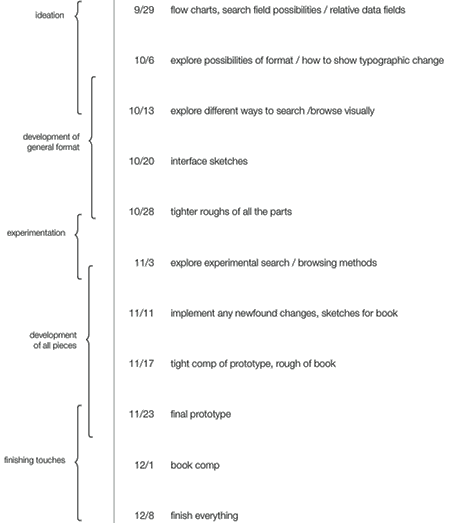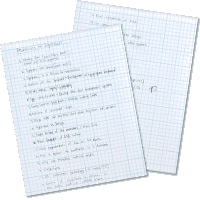Long before the semester even started, I began thinking and writing about what exactly it was that I wanted to do.
The first thing I decided to do was make a long list of all the topics I was heavily interested in—or at least enough to be happy spending a semester focusing on. Right from this point I became quite excited about this whole degree project thing. I love to go into ridiculous levels of detail with research and development, and that is something you rarely ever get an opportunity to do.
So, I compiled a list of 30–35 topics which I could imagine holding my attention for a whole semester.
From there, I took a step back broke the list down into 2 categories: the ideas that were based basically on research, and the others that already hinted towards a deeper analysis and need for problem solving. Also at this point I rated each of the ideas on a scale of 1–5 stars.
Ideas that would be mostly research-oriented (but could grow)
| ***** | Lettering from classic horror movie posters and title sequences |
| ** | Boat-related typography (mostly names) |
| **** | Heavy metal logos / typography |
| ** | Evolution of the shape of skateboards |
| **** | Graphic history of sea monsters / Moby Dick |
| * | Visual language of LSD culture |
| ** | Subway maps |
| * | US government symbology (on money, etc) |
| **** | Visual representations of music |
| ***** | Macabre design through history |
| **** | Graphic history of the solar system |
| ** | Design on the edge of albums / spine design |
| * | Clock faces |
| * | Thermometer faces |
| ** | Rulers / slide rules |
| ** | Moon phase calendars |
| ** | Halftone technology |
| * | Fruit stickers |
| * | Bottle caps |
| *** | Candy wrappers |
| ** | Printer’s fists |
| ** | Hubcaps |
Ideas that move beyond research (analysis, problem solving, etc):
| *** | Typography as it relates to architecture |
| ***** | Evolution of the keyboard; Development of a typographers keyboard |
| ***** | Type classification systems; Development of new font management system |
| ***** | Visualizations of a digital music library (iTunes) |
| **** | Famous / important typographers; Development of typographer trading cards |
| *** | Design fads – how they start, where they’re born, and where they exist |
| * | Stylization vs Design |
| *** | Visual representations of how to tie knots |
| ** | Ways to represent the spherical earth in two dimensions |
| * | Why the MassArt website sucks |
| *** | Evolution of letterforms in relation to the tools used to make them |
| * | Why DVD menu screens suck; how they could be better |
| * | Advertising / the (disgusting) culture of persuasion |
![]()
I think the main reason I settled on the subject of type organization was that it was a real, existing problem that affected me. Sure, it would have been cool to create visual representations of a music library or go with any of my other ideas, but this was a real problem that I myself had wished someone else would solve.
So I was able to settle on the general topic. The next obvious step was to focus in on exactly what problems I wanted to solve. I still had no idea how I was going to go about it all, but I knew for certain that current tools just didnt cut it.
The topic which I would like to pursue as a basis for my senior degree project (as of now) is typographic classification, more specifically the development of a more efficient, intuitive, effective tool to search, manage, browse (and sell?) a library of type.
I hope to explore the variety of ways in which type can, and has been, sorted and navigated; from there I would like to implement my findings in a new tool that takes advantage of the rich amounts of information that are hiding within a library of type.
![]()
So I knew what the problems I wanted to address were. Next step: defining what I proposed to do in order to solve these problems.
Below is the official proposal I was required to submit for approval from my degree project instructor, Brian Lucid; written 29 April, 2005. On the yellow notes are his initial comments.
For my senior degree project, I would like to base my research and work on the topic of typeface organization and classification. My plan, as of now, includes the development of a new tool to assist in the process of organizing a library of type. This tool may also be developed as an educational tool for typography, or as a selling tool.
'this sounds great, but put these features in a heirarchy... the tool can not do everything equally... what are the most important features to you?'
When I was initially coming up with a topic on which to base my senior degree project, it was a bit overwhelming; I had so many interests that I would have been excited to research. I figured that to narrow my choices I would limit the directions to ones that could possibly lead to a solution for a problem that already existed (as opposed to searching for problems in whichever topic I was most drawn to).
This got me thinking about my dissatisfaction with current typographic organization and classification systems. Most of the existing methods are very one dimensional; they group each typeface or even type family according to only one factor, and often do so using very amateur reasoning.
'this is your core point... and a good one at that... in a world where we have so many tools that connect information in a multi-dimentional way, our type classification is one dimentional...'
It is my belief that the history and information related to typography is just as rich and complex as that of music or fine art. Sadly, most of this information vanishes from sight and is disregarded when organizing a library of type. I believe that all this complex information can, and should be, harnessed to assist in the construction of a type library. This information can help designers to make informed decisions in their typeface selections and combinations.
'yes, but in many ways this layer should be secondary... once the user has identified a face or style, then they can follow a thread to find its history and appropriateness..."
And beyond that, the information about typeface inter-relations and historical significance is a piece of art history. This information, if released from old books, can become a new interactive learning experience to help people see the craft and history of typography in a new, brighter light.
'yes... as I mentioned above, the interest in interconnection is a by-product of our modern times... this is one area in your research that I would be particularly interested in...'
Before I figure out the details of exactly how to solve my problem, I would first like to research other typographic classification systems, past and present, and evaluate their strengths and weaknesses. It might even be helpful to research classification and organization systems and software in general, maybe to pick up on aspects that may not have been applied to typography before but might have value in one way or another.
'a historical awareness of the different classifications is key here... but use some common sense too... who is your audience, and what would make it easiest to find what they need. Are they "educated designers" who know the jargon and history, or do they simpy know what they see in the shapes of the letters... both are interesting targets... just different....'
After I have done this research, I would ideally like to implement my findings in the development of a new organizing / browsing / classification / educational / selling / management system, probably in the form of digital software (maybe it doesn’t do it all, but it would be nice). Again, though I don’t know exactly how I will do this, I am imagining a tool that is for typography what iPhoto is for photography—probably even more powerful. It would be wonderful to create “Smart” collections of typefaces and sort and re-sort typefaces using meta data tags; to have similarities between typefaces highlighted or have the ability for to rate them. The main idea is that the information related to each typeface is not static and stuck to a one dimensional line, but instead is dynamic—able to be shuffled and automatically sorted using the information already related to the typeface; information that might be invisible in another classification system.
![]()
…and Brian's final comments:
'the above is well described, and your idea seems well formed... your features may be a bit too broad right now, but you can cut features in the process... so (in my opinion) here is what you need to figure out:
1. Who is using this? what is thier prior knowledge of type? how sensitive are thier eyes (many untrained people don't notice the difference between a sans- and serif face, for example... believe it or not)
2. what are thier real needs? How would they use this in the course of a day?
3. Perhaps create a matrix of three users... expert, designer and "i know nothing about type" (if you want such an audince... its your choice) and lay out thier knowledge and expectations.
4. once you have that, you can start developing a good, common sense organization structure based upon your research into past systems... this is the most interesting part of your project to me... I would be curious to see your solutions to classifying type... beyond such simple axes as time or location (which are helpful too) how can you group type in new ways that have not been considered? perhaps is it the bringing together of many different types of classifications at the same time...
5. as you do this, consider your role as author within this process. you mention "smart" organization and meta data... how much of this comes from the type foundries? how much comes from you as master organizer? how much could come from the community of users who engage this system?
6. you might find it helpful to develop a short list of sample typefaces that you can use as your source material... from classic faces to pixel fonts ... by creating a small collection you have a managable amount of research and have everything you need to develop a few user scenarios... I know that you have a pretty good grasp of this stuff... particulary type history.'
My Personal Timeline of goals
With a good idea of what lay ahead, I knew there would be various tasks that would need to be executed in order to reach the final piece. So as not to let myself spend too much time on research and experimentation (as I often find myself doing) I figured it would make sense to have a project timeline from the getgo.
As you will note below, my timeline also had to accomodate for the required "process book", which is exactly what you are reading now.

With my idea in a good state and a timeline to guide me, I was ready to move on.
The next stage from here was research.
